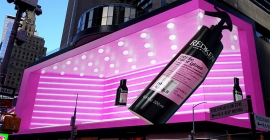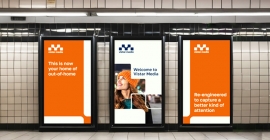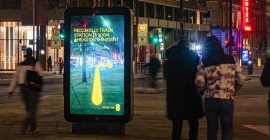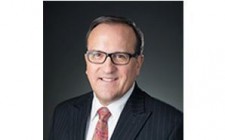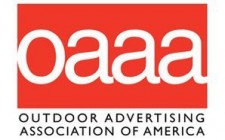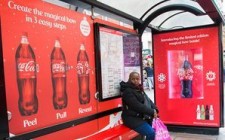Home » Digital OOH » Five Trends for OOH In 2016: Naren Patel, CEO, Primesight
Five Trends for OOH In 2016: Naren Patel, CEO, Primesight
By Posterscope - February 22, 2016
Out-of-home (OOH) adspend in the UK broke the £1 billion barrier in 2014, and is predicted to grow by 4.8% in 2016, according to forecasts from the Advertising Association and Warc. Here are five trends for OOH In 2016 according to Naren Patel, CEO, Primesight
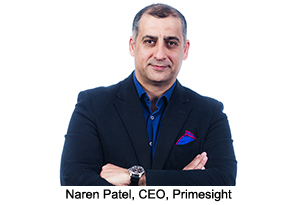 Out-of-home (OOH) adspend in the UK broke the £1 billion barrier in 2014, and is predicted to grow by 4.8% in 2016, according to forecasts from the Advertising Association and Warc. But what are the trends that will help the industry achieve - and hopefully better - such predicted growth?
Out-of-home (OOH) adspend in the UK broke the £1 billion barrier in 2014, and is predicted to grow by 4.8% in 2016, according to forecasts from the Advertising Association and Warc. But what are the trends that will help the industry achieve - and hopefully better - such predicted growth?1) Audience selling: moving from panel to people
Route, a research firm which produces audience estimates for OOH advertising, is now an intrinsic part of any outdoor campaign planning process. But in 2016, the industry will actively move towards Route becoming the base point for the entire trading process. This is being driven by two streams of influence.
Firstly, the rise of the internet and programmatic trading has highlighted the core function of ad investment to buy audience exposure, rather than investing to own a piece of real estate. Whether the platform is a classic poster or a digital display, it is necessary to quantify the audience reached and allow advertisers to integrate this data with their increasingly sophisticated econometric investment models.
Secondly, as automated trading systems are developed by buyers and sellers to improve operational efficiency, they will need to incorporate a base audience impact measurement which is recognised by both buyers and sellers as part of the OOH format and location valuation. Route provides this underlying base data for nearly all the frames in the UK and has been a successful joint investment by buyers and sellers across the industry.
2) Layering: better blending of digital and classic OOH
Digital out-of-home (DOOH) will continue to develop at pace throughout 2016, with research from BrandScience suggesting an optimum 45% of the OOH budget should be allocated to DOOH. The same research, however, also concluded that digital should only account for 20% to 25% of frames, which presents a problem as digital costs significantly more than classic OOH.
Advertisers will begin to use DOOH more effectively alongside classic OOH, making use of the unrivalled reach of traditional poster sites with the ability to buy digital posters in day parts that are best suited to deliver the required audiences, making DOOH more effective in the process.
Digital amplification of the power of classic OOH requires a fundamental link between the creative process and the delivery platform in order to create the right ad at the right time. This year will see creatives think more broadly about what "out-of-home†means to their specific advert in terms of the what, why, where, when and how.
More frequently, the medium itself will contribute to the message - and creatives need to design with this in mind for both digital and classic OOH.
3) Automation
Global spend for programmatic digital display advertising is estimated to reach $53 billion by 2018, according to Magna Global. And OOH will play a meaningful part in that growth.
As hinted at by this shift, we are about to enter the third era of transaction. The first involved carbon copy and Royal Mail; the second, in the early-1990s, brought Excel and email. The third is all about demand-side platforms (DSPs), supply-side platform (SSPs) and application programming interfaces (APIs).
This requires improved data structures and encoded transaction rules, both of which the OOH industry is actively engaged in developing, having launched SPACE as the core inventory database in autumn 2015. The unique data-management application - which stores, categorises and standardises every piece of OOH inventory within the UK market - means the transfer of data will be improved, and makes automation and programmatic ripe for growth in 2016.
There are three important developments for transaction technology in OOH:
- "Pull-to-trade†links the inventory management systems of media owners to their major trading partners and enables partners to pull details of suitable inventory by format and location, as well as providing a real-time assessment of classic poster inventory availability.
- "Click-to-buy†enables the open purchase of a billboard through online search, transaction and artwork provision. Several software companies have developed interfaces to make this work. The system effectively operates as a selfservice shop enabling easy access to new customers, as well as improved efficiency. It is already in use in some markets around the world.
- "Download-to-digital†is seeing companies develop plug-ins that connect online digital trading desks to the outdoor digital inventory.
4) Media owner cross-fertilisation will begin
Areas of interest among media owners will become less siloed. Companies in the OOH industry will branch out further from their original areas of expertise and develop links with mobile, tech and data companies. Expect to see OOH strengthen relationships with mobile and hyper-local online ad sales. If OOH is being used to target audiences based on proximity, it would make sense to serve online and/or mobile impressions to the same audience.
Digital OOH also makes it possible to sync advertising across multiple channels. Lucozade's "Find Your Flow†campaign is a good example of this cross-fertilisation, as it effectively synced radio spots with digital billboards.
Media owners will look to offer more than just advertising space and will adapt to the changing, connected urban environment. We expect to see more beacons and WiFi networks deployed in 2016, and live data feeds will be used more frequently to drive the creative content on Digital OOH.
5) OOH will be seen as the next growth medium
The presence and reach of OOH continues to grow as the population - and the amount of time people spend out-of-home - increases, while the substantial financial investment in product is accelerating, too. OOH's ability to act as a primer for more interactive channels is being better understood. This traditional medium has never been more current.
Research from BrandScience confirms this, finding that increased investment in OOH as part of the communications mix drives ROI for advertisers. More specifically, the report recommends that, for sales effect alone, grocery retailers should use OOH as the lead medium for spends of under £25 million a year.
The article was first published on 11th January by Warc, a source of ideas and evidence for marketing professionals.

Stay on top of OOH media trends
Advertisement

